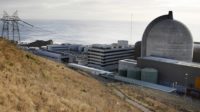With the days getting hotter and tropical activity picking up in the Gulf of Mexico, concerns are mounting about the reliability of the Texas power supply after the state’s main grid operator asked residents to go on a five-day energy conservation diet.
On June 14, the Electric Reliability Council of Texas (ERCOT), the organization that operates much of the state’s power grid, issued an alert urging Texans to conserve power as much as possible through June 18, citing “tight grid conditions” caused by a combination of unexpected power plant outages and the potential for record energy use in June.
The day ERCOT issued the alert, over 12,000 MW of power generation — enough to power 2.4 million homes on a summer day — was offline to allow for plant repairs. That same day, ERCOT set a new June record for electricity demand, reaching 69,943 MW, while predicting a peak demand load of 73,000 MW of the grid’s 86,862 MW of generating capacity.
Just a day after issuing the alert, ERCOT reported the reliability of the grid remained “strong” and that the grid had regained 1,200 MW of power overnight when some of the plant repairs were completed.
“The grid is operating exactly as it was designed and intended. The issuance of conservation notices is a common practice and prevents ERCOT from entering emergency conditions,” an ERCOT release stated.
This marks the second time since April ERCOT has issued an alert urging customers to conserve energy, and the latest request comes just four months after a deadly winter storm left over 4 million Texans without power and resulted in over 150 deaths – many of which were related to hypothermia.
The Texas grid has come under scrutiny since then, with everyone from regulators and policy makers to engineers and industry observers keeping a watchful eye on the state’s power supply. In May, the North American Electric Reliability Corp. (NERC) issued a report warning that Texas was at an “elevated risk” for energy emergencies in the summer of 2021 during above-normal peak temperatures.
A spokesperson for NERC, the authority that regulates electric reliability in North America, told ENR that ERCOT’s call for energy conservation was a “prudent measure” to help minimize the stress on the power system.
“In past summers, where it has experienced very high temperatures, Texas has performed well. However, it remains at risk during extreme weather events that prompt peak demand. This could be further exacerbated if those high temperatures are coupled with unplanned generator outages and low wind production,” says NERC spokesperson Rachel Sherrard.
Daniel Cohan, associate professor of civil and environmental engineering at Rice University in Houston, says it will take more than requests for voluntary conservation — during a week of tight conditions — to make lasting change.
“There hasn’t been enough investment in what’s needed for a reliable power supply. And that’s been a lack of investment in new transmission lines, a lack of investment in efficiency for homes and businesses, and a lack of investment in weatherizing the power plants we have and building new power sources as needed,” Cohan says.
What’s concerning about the June conservation alert, Cohan says, is that the hotter months of summer are yet to come. “The more likely scenario this summer is that we get a heat wave in July or August, with the wind flow and some power plants malfunctioning, that could really push us to a need for rolling blackouts,” he says.
Troubleshooting the Grid
Stabilizing the Texas power supply won’t be an easy fix, and energy experts, including at the American Society of Civil Engineers, are trying to get to the bottom of what needs to happen to make sure the supply keeps pace with demand.
After the 2021 winter storm, the ASCE created an infrastructure network resilience committee to conduct a forensic analysis of what happened to the state’s infrastructure during the 2021 winter storm, and what changes need to happen. The committee plans to report on its findings and make recommendations later this year. Committee chairman and energy consultant Geoff Roberts says the answers will probably be more nuanced than what people might expect.
“I think there’s a tendency — especially among engineers — where we want to point to ‘the thing.’ And if we do that too early, we might be solving the wrong problem,” says Roberts, who also co-chaired the energy subcommittee for the ASCE’s 2021 Texas Infrastructure Report Card.
The Texas energy sector received a B+ rating for 2021. But in the days following the deadly winter storms, Roberts says Report Card committee members started emailing back and forth about the need to further assess the state’s storm-battered infrastructure.
Infrastructure systems consist of many moving parts, Roberts explains. Not only are there the physical assets, but there are also the rules and regulations governing how those assets operate. “When you want to figure out what needs to be fixed, it may be as simple as paperwork, or that the process needs to change,” Roberts says.
Also a factor is how different infrastructure sectors interact, such as how stresses on natural gas systems might affect power and electrical infrastructure.
“When we looked at things before, we looked at them by sector. But this interconnected nature makes this a much more challenging situation to resolve,” Roberts says.
While ERCOT is sounding the alarm bells with its calls for power conservation, the operator may also be doing so out of an abundance of caution, he explains.
“People are still sore from February,” Roberts says. “But I also think the reality is there may be some aspects that were underemphasized in the past, and nobody wants to be the one caught short.”


